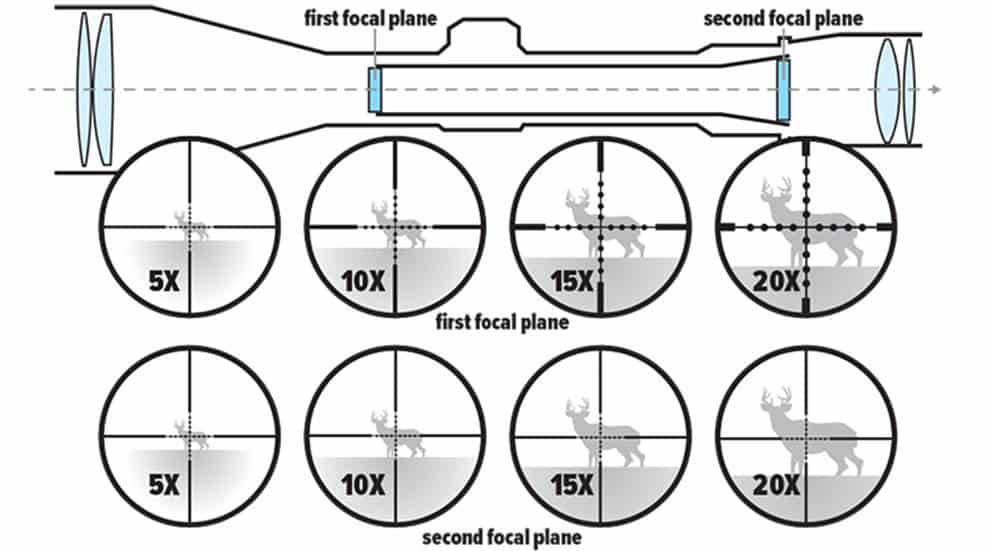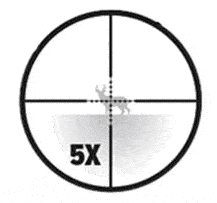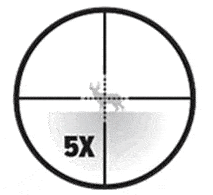Do you know the difference between the first vs second focal plane scopes? When it comes to understanding rifle optics, you must spend some time with rifle scopes to know the differences.

Let’s start with a simple definition of both focal planes.
The reticle found in a first focal plane scope (FFP scope) grows bigger as you zoom. Its size does not vary relative to the aim/target since both increases in size and get bigger simultaneously.
The reticle that is found in a second focal plane scope (SFP scope) remains the same even when you zoom in and out of the rifle scope with the magnification adjustment. The only thing that grows in size is the target, the reticle remains the same.
First Focal Plane Optic (FFP optics)

Let’s go over what an FFP scope is and how it works while you’re shooting. A Diamondback Tactical 6-24×50 FFP – Vortex Optics is a nice example of a first focal plane scope. When you zoom in and out of this rifle scope, the FFP reticle size will change. An FFP reticle becomes smaller when you zoom out of the riflescope, and it becomes bigger when you zoom in.
An FFP optics has MOA dots on the windage line of the scope. The gap between those dots grows bigger as you zoom closer. This means that when you zoom closer, you’ll have a better picture of the MOA adjustments you’ll need to make while shooting from a great distance.
Simultaneously, the zoomed-in and bigger reticle will cover most of the target object you’re aiming at. This is inappropriate for many hunting and competitive shooting circumstances. This reticle expansion might be a problem for long-range shooters. For example, if you aim at a medium-sized game, an FFP reticle might cover the game when you try to zoom closely at 1,000 yards distance.
The real size of a first focal plane reticle remains constant, just that the reticle is magnified and becomes bigger in your view. To clarify this, you must know that an inch is an inch whether the image is at 1 yard, 50 yards, 100 yards, 1,000 yards distance, or more. It just appears differently depending on the distance you are zooming at.
Second Focal Plane Optic (SFP optic)

If you really want to engage in long range shooting, then you should understand what a second focal plane scope is and how it works. An SFP optic is one in which the reticle size remains constant regardless of the change in the scopes magnification. Whether you zoom in or out (higher magnification or lower magnification), the reticle size would remain the same in your sight.
An SFP reticle will not obscure your target at long ranges. As you zoom in, the reticle size does not increase, but the image size would increase. When you zoom out, the reticle size still remains while your image decreases. This also implies that you won’t be able to evaluate the MOA as precisely as you would with a first focal plane scope.
Hunters and other shooters have been using the second focal plane scopes for a long time, but the first focal plane is a new arrival to the world of rifle scopes.
The Distinction
Consider this illustration to properly understand the distinction between the two focal planes. Get a yardstick that has an inch measurement and place the yardstick about 10 feet from you. Would you be able to see the inch measurements? No. Now place the same yardstick 2 feet away from your eyes. Can you now see the inch measurements? Maybe a little. Finally, place a magnifying glass on the same yardstick. What do you see? I bet you can now see the measurements clearly as the spacing between each inch line is now bigger.
The last part of this illustration (viewing a yardstick with a magnifying glass) helps you to see the space between each inch clearly, but that does not mean that the gap between the inch was increased.
When using a first focal plane riflescope, you can divide the MOA markings into smaller portions. When aiming at a deer, the chest portion of a deer is around a foot broad. When you adjust to a higher magnification on an FFP scope with a hash mark, the space between each mark will appear bigger. What happens is that you get a closer view of the deer, which is covered with an expanded reticle.
The reticle size on a second focal plane riflescope stays the same, and you cannot magnify the spacing between the markings.
Another Difference
Another difference between the two focal plane scopes is that the first focal plane can expand, and when this happens, some parts of the reticle may vanish from view. You will need those reticle markings if you want to make changes or adjust for distance or wind. To see the remainder of the reticle markings in the riflescopes view, you must zoom out of the scope and go back to a low magnification. When you zoom out, your target becomes smaller in relation to your vision. A small target might become too small to see or aim accurately before shooting.
A second focal plane scope allows you to use the whole reticle every time. With this type of optic, fractional MOA modifications would be more difficult. Return to the yardstick example. Can you plainly see an inch measurement from 10 feet away? What about 2 feet? These minor changes may not seem significant, but when shooting at small targets like squirrels, they do matter.
FFP VS SFP: How to Choose?

Choosing between an FFP and an SFP scope demands more thought than simply going by personal taste. Other things that must be considered include magnification needs and how the scope will be utilized the majority of the time.
Hunting
What is the ideal focal plane for hunting? There are two elements to consider: terrain and magnification. FFP scopes are suitable for high power and mountainous terrain, such as large game hunting in the West. SFP scopes are ideal for low magnification hunting in woods or brushes.
Generally, a riflescope with a magnification range of 3-9x or 4-16x is an excellent setup for most hunting situations since they cover a lot of ground. In low-light settings, an SFP reticle has a better visibility even at a low magnification, this is an advantage of SFP optics that the FFP reticle does not have.
An SFP with normal reticle visibility is also preferable in tough brush and dense wood settings. The crosshairs on FFP reticles might become excessively tiny and difficult to see.
FFP allows for precise holdovers at any level of magnification, and it can be fully utilized if you frequently hunt with magnifications greater than 12x. This is ideal for long-distance and mountainous terrain. Resolution, clarity, and brightness are best attained at lower magnification, and because FFP scopes struggle with reticle visibility in low magnification and low light, the SFP remains a deer hunter’s preferred focal plane scope.
Long Range
Long range shooting frequently requires high magnification and plenty of dialing in or reliance on the reticle. Long range shooting is best achieved with an FFP scope, whether you are hunting or it’s a competitive shooting.
The best riflescope for long range shooting is an FFP reticle. The first advantage is that you can get the most out of a complicated reticle. Several windage and elevation holdovers that are always correct regardless of magnification allow for quick and easy judgments. This advantage also increases confidence in limiting POI shifts while adjusting the power.
Second, when you increase the power, the reticle expands in size. This improves the visibility of the hash marks, crosshairs, or dots. The downside is that the FFP reticle can obscure a significant part on extremely small targets, making precise shots more difficult.
Is it preferable to use FFP scopes or SFP scopes for long-range shooting? Second focal plane scopes are great for bench shooters who are not on the clock and are satisfied with firing at maximum magnification. High-quality turrets and glass are required for this. Regardless of the magnification, the reticle will always be visible. FFP, on the other hand, is more suited to the task.
AR15
An AR-15 is a popular weapon that is used for anything from target shooting to law enforcement, hunting, and competitions. FFP or SFP scopes may be mounted on an MSR to meet your needs and applications. The choice between an FFP and an SFP scope for an AR15 rifle or any other type of MSR boils down to the application and the magnification range you will be using most.
A second focal plane scope is suited for a wide range of applications, particularly for a lower magnification that is less than 12x. In comparison to FFP scopes, SFP scopes are highly user-friendly. A maximum of 12x or even 14x with SFP is sufficient for most long-range shooting.
Long-distance shooting, competition, and various hunting methods will benefit greatly from FFP. Being able to raise the magnification but not max out and still have precise holdovers is crucial for these applications.
Because an AR can accomplish so many different things, the focal plane scope you choose should be appropriate for what you want to perform with it.
Combat
A reticle will be installed on either the first focal plane or second focal plane of a Low Powered Variable Optic or a high-powered optic for combat or other defense circumstances. CQB performance is critical in most professional contexts.
The SFP reticle is stable, visible, and well-suited to close-quarters combats. Even when changing magnification at about 250 yards, there should be no reason to hold on to a man-sized target. Many law enforcement combat encounters are near, and sniper targets might be closer than most people believe.
For tactical usage, you may choose between FFP and SFP scopes, but with a 50-100 yard zero, SFP will do for close-to-mid ranges.
FFP reticles have their uses and may be quite useful on magnified lenses while holding over or for quick adjustments and follow-up shots.
Do snipers need an FFP scope or an SFP scope? It all depends on who you ask. It could also depend on whether it is military or law enforcement. Most times, the budget is more important than the preference for reticle focal planes.
3-Gun/Competition
Speed and precision are the major factors that a rifle scope must have for 3-Gun and other forms of shooting competitions.
FFP scopes are usually preferred by precision marksmen. Fast shots are made possible by the ability to use precise holdovers at any magnification. You might waste time dialing in an SFP scope or get trapped at max magnification all the time.
Top competition scopes often have a very broad magnification range, allowing for customizable FOVs at different target distances.
The FFP’s disadvantage is that the reticle can become narrow at low power, making it difficult to see the center dot. Lighting can assist in solving the situation. Nonetheless, the SFP has the benefit of always being at its regular and viewable size.
Pro Tip: In contests where more than one optic is permitted, a shooter can combine an FFP scope and a red dot sight at an offset mount of 45-degree.
Target Shooting
Target shooting can take many forms, ranging from rimfire fun, plinking, and 100-yard shooting to measure the shooter’s scope ability and long-range skills. The second focal plane reticle is the ideal scope for most applications other than long range.
Many people do not require FFP scopes, and target shooters are among them. Most target shooters do not compete against the clock. They will be fine with an SFP scope because they have all the time to dial in adjustments.
First focal planes are sought for long-range target shooting or for individuals who need a scope for aged eyes to view a bigger reticle. More magnification does not make you better at shooting, but it does improve your vision.
Which is Better for You?

The appropriate scope will be the one most suited to the planned application. If affordability is the only consideration, the SFP is the better choice because FFP reticles are almost usually glass-etched, and precise alignment is required. Beyond the cost, select the rifle scope that provides the most benefits for your shooting need.
FFP is ideal for long-distance, competition, high magnification, and some professional hunting and tactical applications.
SFP is ideal for target shooting, hunting, and CQB situations. If you don’t hold over frequently, desire steady reticle visibility, or frequently fire small targets, then SFP is your best bet.
A skilled shooter should be able to find ways to reduce and cope with some of the challenges inherent in both focal planes. Don’t allow hard math, a limited budget, or pre-existing biases to prevent you from selecting the best form of scope!
Inforgraphic For First and Second Focal Plane

You can copy code below to share this Infographic On Your Site

Mike Hardesty is a published freelance gun writer. He also possesses specialized expertise in rifle scopes With dozens of articles and reviews published in Pew Pew Tactical, Snipercountry.com, and TTAG (The Truth About Guns), Mike is considered a firearms expert. His special area of expertise is handguns.
Mike is a long-time shooter. He has been punching paper targets, taking deer and other game and shooting at competitions since about 1975. Other related pursuits include reloading and bullet casting. He currently reloads for over 10 calibers, both handgun and rifle. His reloads, particularly for 9mm, were in great demand during the height of the ammo shortage among family and friends. He donated hundreds of rounds to informal shooting sessions. He was quoted as saying “I do not sell my reloads but I sure will help my guys shoot ’em for free!”. He has a few cherished firearms that he has inherited or otherwise procured — those are his favorites.
He earned B.S. and M.S. degrees from Indiana State University in 1974-1975.
He’s a firearm experts and is the founder of mhardesty.com.
